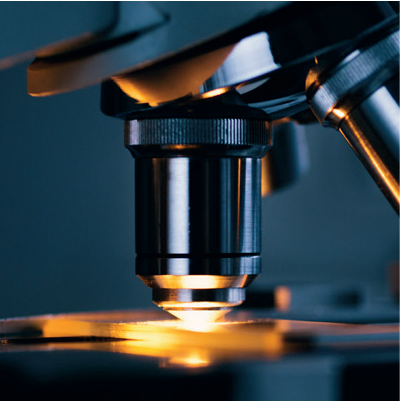PHOTOMULTIPLIER TUBES (PMTs)
Multi-Anode
Ultra-fast, spatially segmented photomultiplier tube

Features
Single photon counting
with individual anode timing to < 30 ps rms
Ultrafast analog response
to accurately measure picosecond scale transient events
Extremely low dark counts
for enhanced signal-to-noise
Highest anode density of any PMT
for better spatial resolution
Coated MCP options
for long lifetime in high event rate environments
Immunity to magnetic fields
for operation in accelerator facilities
Applications
- Ring Imaging Cherenkov (RICH/DIRC)
- Scintillating/Cherenkov fibre readout
- Beam monitoring
- Time-of-Flight positron emission tomography
- High content screening
- Time resolved spectroscopy
- LiDAR
- Standoff chemical/biological detection
- Microplate readout
- Fluorescence Lifetime Imaging Microscopy (FLIM)
Overview
The Photek family of Multi-Anode Photomultipler Tubes (MAPMT) utilise Microchannel Plate (MCP) electron multipliers to provide the world’s fastest MAPMTs, with individual pulse risetimes to 175 ps and Transit Time Spread (TTS) to 30 ps rms. There are multiple configurations to choose from, depending on requirements:
MAPMT253
A 59 mm tileable square format, with a 53 x 53 mm active area, with standard configurations of 64, 256, and 1024 anodes.
MAPMT226
A ruggedised 80 mm package with a 26.5 x 26.5 mm active area having 256 anodes.
Both variants can be customised with unique anode patterns and connectors. Multi-Anode PMTs require high voltages to be supplied for operation. High Voltage Divider Networks are available for all detector configurations, please contact Photek for more details.
Range
The table below outlines the Part Number format for our standard product range. To talk further about these products, or bespoke solutions for your application, then please Contact us.
Example: MAPMT226/Q/S20/16×16
is a 26mm diameter dual multi-anode photomultiplier tube, with a fused silica input window, S20 photocathode, and 16 x 16 anode.
TYPE | Size | Input | Photocathode | Anode |
MAPMT2 | 26 | Q (Fused Silica) | BI (Bialkali) | 8 x 8 |
53 | S (Sapphire) | S20B | 16 x 16 | |
*IFO (Fibre Optic) | S20 | 32 x 32 | ||
*M (MgF2) | S25 | |||
*SB (Solar Blind) |
*IFO, *M and *SB only available on the 26 mm model
Specifications
Electron Multiplier | Dual MCP |
Active Area | 53 x 53 mm |
Window | Fused Silica (Optional: Sapphire) |
Photocathode | Bialkali, S20B, S20, S25 |
Anode Formats | 64 x 64 on 0.828 mm pitch 32 x 32 on 1.656 mm pitch 16 x 16 on 3.312 mm pitch 8 x 8 on 6.624 mm pitch |
Electron Multiplier | Dual MCP |
Active Area | 26.5 x 26.5 mm |
Window | Fused Silica (Optional: Sapphire / Fibre Optic / MgF2)
|
Photocathode | Bialkali, S20, S20B, S25, Solar Blind |
Anode Formats | 32 x 32 on 1.656 mm pitch (not available with connectors) 16 x 16 on 3.312 mm pitch 8 x 8 on 6.624 mm pitch |
Photocathode Response

The underlay on the cathode can affect the QE.
Optical fibre optic window will reduce sensitivity and no response below 300nm.
Average Single Photon Pulse

Average of 50 single photon pulses
measured on 5 GHz, 20 GS/s LeCroy oscilloscope,
using sin(x)/x interpolation and illuminated using a
Photek LPG-405 pulsed laser.
Documentation
Related Topic

Application Title
Lorem ipsum dolor sit amet, consec tetuer adipiscing elit, sed diam nonummy nibh euismod tincidunt.

Application Title
Lorem ipsum dolor sit amet, consec tetuer adipiscing elit, sed diam nonummy nibh euismod tincidunt.

Application Title
Lorem ipsum dolor sit amet, consec tetuer adipiscing elit, sed diam nonummy nibh euismod tincidunt.

Application Title
Lorem ipsum dolor sit amet, consec tetuer adipiscing elit, sed diam nonummy nibh euismod tincidunt.
Also Consider
Electronics
Frequently Asked Questions
An MCP-PMT is a microchannel-plate photomultiplier ideal for ultra-fast, low-jitter detection. It excels with fast transient phenomena thanks to sub-nanosecond rise times, low transit time spread (TTS) and minimal after-pulsing – perfect for TOF, LIDAR, FLIM, and other high-speed pulsed applications.
Yes. MCP-PMTs with dual (chevron) or triple (z-stack) MCPs deliver high gain and low noise with excellent timing resolution, ideal for time correlated single photon counting (TCSPC), Cherenkov, and LiDAR.
Photek MCP-PMTs achieve transit time spreads in the tens of picoseconds for single-photon detection, and below 10 ps for multi-photon signals, depending on the model. We can recommend the best configuration for your timing needs.
MCP-PMTs are highly resilient in magnetic fields compared to dynode PMTs. Certain models of Photek MCP-PMTs have been shown to perform well in fields of up to 2 T and remain operable at up to 5 T.
UV to NIR wavelengths are covered with solar-blind, bialkali, and broadband visible photocathodes. Input window options include fused silica, fibre optic glass and specialised materials where required. We match optimal QE and entrance window to your wavelength range.
Both single and multi-anode arrays are available, with configurations up to 64 × 64 outputs. Multi-anode designs enable multi-channel timing, coincidence detection, or spatially resolved measurements.
Photek MCP-PMTs are best suited for detecting ultra-short, high-intensity pulses rather than continuous high-brightness signals. The usable event rate depends on pulse width, duty cycle, and MCP recharge time. Contact the Photek team to determine the best configuration for your application.
Lifetime relates to the total extracted charge from the microchannel plates (MCPs). Specially coated MCPs and optimised operating gain can extend lifetime significantly. Photek can provide guidance on options and optimal operating parameters for demanding applications.
Yes. Fast gating down to < 3 ns is achievable, allowing background suppression and time-resolved detection. Suitable gating modules are available from Photek.
Yes. We can customise the mechanical design, anode configurations, connectors to suit your application. Supporting electronics, including high-voltage power supplies and gating modules, are offered by Photek.


